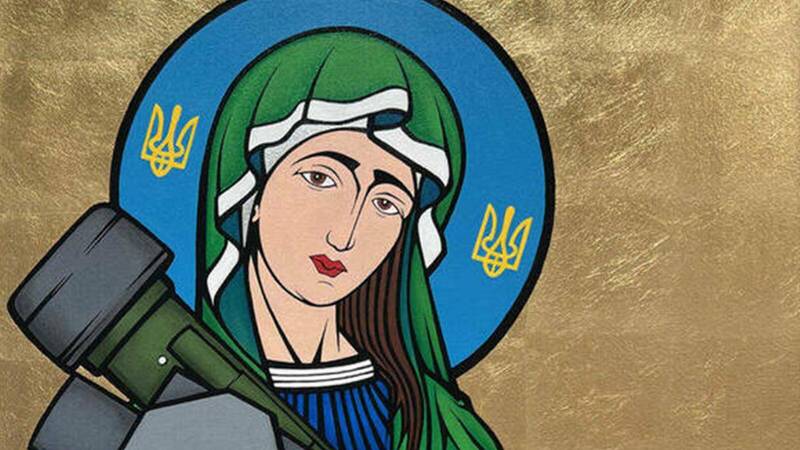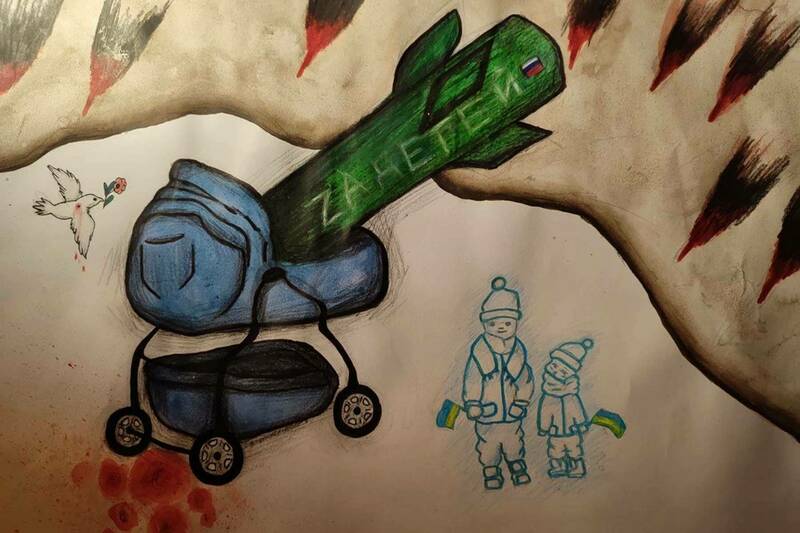
Children's War Art
Ukrainian Art as Protest and Resilience
By Libby Eggemeier '25
Artist: Alina Volochysk on UA Kids Today
Format: Drawing
Placement: Online gallery
Janusz Korczak, a Polish Jewish doctor and writer who sheltered and protected young orphans during the Holocaust, wrote “children are not soldiers, they do not defend their homeland, but they suffer with it.” Korczak implores humanity to view war through the innocent eyes of children whose lives are engulfed by violence. The war in Ukraine, following the full-scale invasion launched by Russia in February 2022, brings daily reminders of these forgotten victims of conflict. Children are sustaining psychological injuries as they flee their homes and escape to refugee shelters and camps. In strikingly similar ways to the young victims of previous wars, Ukraine’s children are expressing both their trauma and resilience through “war drawings.”
Despite the abject violence and displacement they endure, Ukrainian children are persevering through their art. Established by Artem and Anastasia Bykovets, parents and Kyiv natives, UA Kids Today collects Ukrainian children’s art in an online exhibition that conveys the suffering and the bravery of some of the country’s youngest citizens. The Bykovets were inspired by their 6-year-old daughter Sophia who relied on art as therapy, using scraps of materials such as napkins and old bags to paint on and make sense of the war around her. The Bykovets remark that children experience unusual stress as “most of their time is spent in basements and bomb shelters … and they can not explain their feelings” and they exist “in a state of uncertainty.”

These impressionable children face neurological ramifications during crucial developmental years. Compounding the cruelty of the war, children in Ukraine are at high risk for sexual exploitation, trafficking, and family separation. Amidst this strife, art can serve as a lifeline for children. Valeriia Polska, a Ukrainian art therapist, reveals the unique healing power of art as she describes how “by drawing, we fall into the world of metaphors and sensory experiences. We reconnect with our emotional world and translate it to others.” In the case of the Russian-Ukrainian war, children use the outlet of art “to relieve pain, form a new sense of self, and adapt to new situations.” This medium encourages children to cope with and unabashedly express their trauma and anxiety.
In Alina Volochysk’s drawing, the Russian missile piercing through the baby carriage painfully encapsulates how Putin’s invasion has robbed Ukrainian youth not only of their childhoods, but has played fast and loose with their lives. UNICEF reports that, on average, over five Ukrainian children were killed or injured each day during the first six months of the war. The white dove, shot with a bullet, relays Russia’s deadly resolve and delivers the message that to kill children is to lose one’s humanity. The two children in Alina’s drawing are holding onto Ukrainian flags and are a vital portrayal of the unassailable strength of the Ukrainian spirit. Alina’s artistic voice is crucial, and her drawings become her weapon of resistance.
In addition to the remedial power of art for children, soldiers on the front line receiving the drawings are revitalized and reinvigorated by the hope and determination of the next generation. The drawings include potent images of soldiers proud to serve their country. For instance, one sketch depicts soldiers and helicopters entering battle with the message: “Ukraine is undefeatable!” This morale boost ignites a fire for these soldiers who are boldly risking their lives for democracy and sovereignty. Ultimately, this art is an unfiltered, vulnerable and authentic window into the pain of the Ukrainian war that helps children and soldiers alike.
Research by Libby Eggemeier ’25
Header image: “St Javelin” by Chris Shaw, acrylic and metal leaf on canvas, completed in March 2022. Image used with permission from Chris Shaw and saintjavelin.com.
Art by Alina Volochysk. Image shared with permission from UA Kids Today.
Read the project introduction and background.